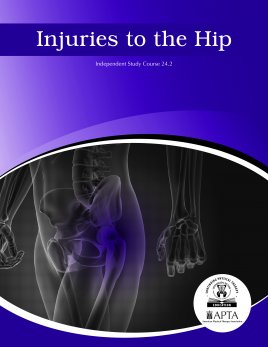
Injuries to the Hip
Contact Hours: 0
| Online Only | |
|---|---|
| APTA Orthopedics Member | $60 |
| Non-APTA Orthopedics Member | $75 |
Note: No CEUs are offered for this course.
Course Description
This course provides comprehensive learning for understanding the structure, function and orthopaedic evaluation and treatment of the hip region. Authors are recognized experts in the field. Unique topics include functional performance testing and biomechanics underlying return to sport following hip injury. The course includes an Exercise Booklet and an online supplement of exercise performance video clips for hip rehabilitation.
Course Overview
Course Format: Online
Course Objectives
- Understand the anatomical and biomechanical imperatives to hip pathology.
- Understand normal developmental morphology of the femur and acetabulum throughout the lifespan.
- Identify developmental factors that can lead to hip pathology across the ages.
- Identify long-term sequelae of abnormal development at the hip.
- Identify factors that may contribute to early degeneration of the hip joint and hip pain.
- Identify common surgical procedures used in the treatment of degenerative hip disease.
- Describe the diagnostic process for identifying and classifying hip injuries.
- Integrate an organized and evidence-based approach in selecting tests and measures for the examination of the hip.
- Understand the distinguishing clinical presentations of intraarticular and extraarticular hip injuries.
- Appreciate the overlap in signs and symptoms between pathology originating from the hip or lumbar spine.
- Describe the performance tests used to assess hip function and evidence for reliability and validity.
- Be able to critically evaluate the role of performance testing in the differential diagnosis of hip pathology.
- Understand the history and evolution of arthroscopic hip surgery.
- Understand the surgical procedures involved in hip arthroscopy.
- Apply sound rehabilitation principles for the nonoperative and postoperative treatment of hip pathology.
- Apply knowledge from hip electromyographic studies to accurately prescribe exercises for hip rehabilitation.
- Be able to design exercise programs that enhance ambulation and function.
- Explain the mechanical demands on the hip during running, jumping, kicking, hitting, throwing, squatting, and lunging.
- Appreciate the role of “the core” on acetabular-femoral dynamics.
- Understand the kinetic chain and the importance of kinetic linking during athletic activity.
- Plan and implement modifications for those athletes with abnormal hip morphology to allow safe participation in both training and sporting activities.
Topics and Authors
- Functional Performance Testing of the Hip
Benjamin R. Kivlan, PT, MS; RobRoy Martin, PT, PhD - Hip Arthroscopy and Rehabilitation
Craig S. Mauro, MD; Kyle E. Hammond, MD - Examination and Differential Diagnosis of Hip Injury
Philip Malloy, MS, PT, SCS - Therapeutic Exercise for Hip Rehabilitation: An Evidence-based Approach
Gordon Riddle, PT, DPT, ATC, OCS, SCS CSCS; Omar Ross, PT, DPT, OCS - The Hip Throughout the Life Cycle
Robert Maschi, PT, DPT, OCS, CSCS; Maureen Suhr, PT, DPT, PCS; Victoria Moran, PT, DPT - Hip Biomechanics During Sport
Peter Draovitch, PT, MS, ATC, CSCS; Elish O’Sullivan, PT, DPT, OCS; Bryan Kelly, MD
Add To Cart
Which version of the course would you like to purchase?
Members Only
You need to be a member to buy this course.
Join today to enjoy exclusive deals and prices on all courses.
Join Now